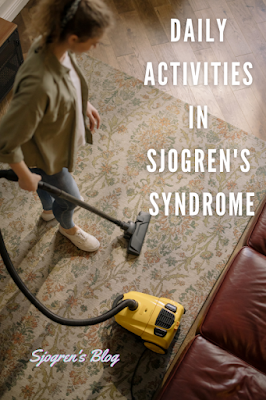This is an explanation of the research, reported in 2022, done in the UK into what interferes with Sjogren's syndrome patient's abilities to carry out tasks. It asks and answers the question 'what symptoms have the biggest impact on daily activities for people with Sjogren's syndrome (SS).
This was a small study of 149 patients with Sjogren's syndrome done in 2021 funded by an Arthritis Research UK Grant.
Key takeaways:
Fatigue had the largest impact on doing activities.
Being diagnosed for a longer time resulted in a better quality of life in SS patients.
The causes of interference of activity were interconnected.
Purpose of the study
To evaluate several aspects of patients’ symptoms, including mood, dryness, fatigue, pain, and brain fog/mental fatigue, and obtain a clearer insight into SS patients and their daily struggles.
Previous research has only looked at one symptom or else taken a broader approach and analysed only the quality of life. This study goes further by looking at multiple different SS symptoms to observe possible activity interferences that patients may face in their daily lives. Further knowledge of how these symptoms interfere with a patient’s activity level could shift the research focus onto treatments that are effective for the most limiting symptoms.
Methods used
Participants were recruited from the UK Sjögren’s Syndrome Registry. A variety of questionnaires were sent out, including the Pain Activity Interference Questionnaire, Fatigue Activity Interference Questionnaire, Mood Activity Interference Questionnaire, Dryness Activity Interference Questionnaire, and Brain Fog/Mental Fatigue Activity Interference Questionnaire and The Hospital Anxiety and Depression Scale (HADS) and the responses were anonymous.
Information was also collected on self-reported patient characteristics including employment status, dependents household income, disability allowance, age, gender, and length of the disease.
Results
88.59% of participants identified as female.
The median age of 63.80 years and range of 55.97 years (minimum age of 32 and maximum age of 88), most 50.67% were retired
66.67% had no dependents living at home.
A significant portion of participants did not receive disability living allowance/personal independence payments or independent living fund
Fatigue was found to have the biggest impact on doing activities; 60% of the highest scoring categories originated from the fatigue questionnaire with ‘physical exercise’ being the activity impacted the most followed by ‘gardening or shopping’ and ‘performing household chores’.
Conclusion
This cross-sectional study investigating which pSS symptoms have the biggest impact on daily activities found that fatigue had the biggest impact on seven activity domains: physical exercise, performing household chores, gardening or shopping, socializing with others, recreation/hobbies, sexual relations and mental efficacy.
An association is seen between each exposure category and outcome results. As an activity interference score increases, i.e. the patient experiencing more difficulty, an outcome score will also increase. However, the length of the disease has been shown to lessen the overall impact of this association.
Importantly, this study looked at the association between activity interferences and mental/physical outcomes, an analysis that has not been previously explored. Results found have given further insight into how SS affects daily life to provide additional treatment options to patients. This study shows the importance of early intervention with support for symptom management, particularly fatigue. However, this research has also highlighted the interconnectedness of symptoms and how they all impact daily activity.
One possible approach within a self-management support package is to identify and use techniques that target several symptoms at once, e.g. activity pacing techniques can be used to manage both fatigue and pain. In addition, the availability of self-management support for fatigue and associated symptoms, may result in an improvement in more than one symptom, reduce activity interference, and ultimately increase the quality of life.
SOURCE: Activity interference in patients with Sjögren’s syndrome: a cross-sectional study of 149 patients in the UK Schoon, H., Slack, E., Pearce, M., Ng, W-F., & Hackett, K. (2022). Activity Interference in Patients with Sjögren’s Syndrome: A Cross-Sectional Study of 149 Patients in the UK. Rheumatology, [keac053]. https://doi.org/10.1093/rheumatology/keac053


Comments
Post a Comment